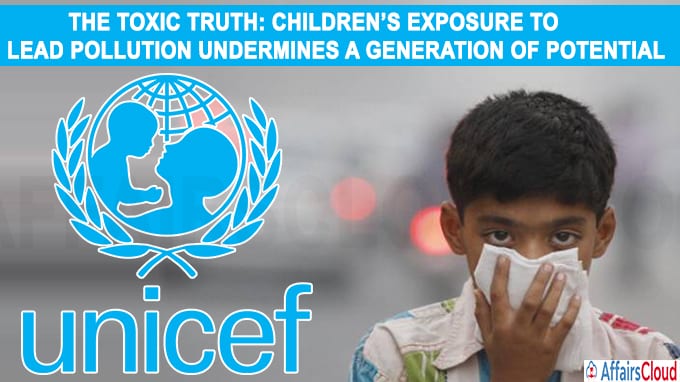 On 30th July 2020, United Nations Children’s Fund(UNICEF) and Pure Earth, international non-profit organization authored and published the first of kind report on the health crisis titled “The Toxic Truth: Children’s Exposure to Lead Pollution Undermines a Generation of Future Potential” states that around lead poisoning affects large number of children all across the globe.
On 30th July 2020, United Nations Children’s Fund(UNICEF) and Pure Earth, international non-profit organization authored and published the first of kind report on the health crisis titled “The Toxic Truth: Children’s Exposure to Lead Pollution Undermines a Generation of Future Potential” states that around lead poisoning affects large number of children all across the globe.
The report states that around 1 in every 3 that is around 800 million children across the world has the blood lead level above or at 5 micrograms per deciliter (µg/dL), the amount at which action is required and Almost 50% of these children live in South Africa.
The Toxic Truth:
The Toxic Truth, is an analysis of childhood exposure to lead conducted by the Institute of Health Metrics Evaluation .
It was verified with the study approved for publication in Environmental Health Perspectives.
Features:
The report features case studies in Kathgora(Bangladesh), Tbilisi(Georgia), Agbogbloshie(Ghana), Pesarean(Indonesia), and Morelos State(Mexico).
Gist of the Report:
i.The report identifies lead as a potent neurotoxin which harms the brains of the children particularly in children under the age of 5 resulting in neurological, cognitive and physical impairments.
ii.The report states that the exposure of lead in childhood is linked to the mental health and behavioural problems which increase the rate of crime and violence.
iii.To the lower and middle income countries, it is estimated to cost around USD 1 trillion, in lost economic potential of these children over their lifetimes.
Reasons for childhood exposure:
i.The leading contributor for lead poisoning in children are the informal and substandard recycling of lead acid batteries.
ii.The increased number of vehicles and lack of battery recycling regulation which lead to unsafe recycling of lead acid batteries in the informal economy
iii.The other factors of childhood exposure to lead are water from the leaded pipes, lead form mining, lead based paints and pigments, leaded gasoline and other active industries.
iv.The lead solder in food containers, spices, cosmetics and other products also results in childhood exposure.
Recommendations:
i.Governments should take steps to build monitoring and reporting systems and to install prevention and control measures.
ii.Equipping health systems to detect, monitor and treat lead exposure.
iii.Government to impose environment, health and safety standards to manufacture and recycle the lead acid batteries.
Note:
The World Health Organisation (WHO), launched the International Lead Poisoning Week of Action from 20-26th October 2019 to enforce standards to stop the manufacture and sale of paints that contain lead. In 2020 the International Lead Poisoning Week of Action falls on 25-31 October 2020.
About UNICEF:
Executive Director– Henrietta Holsman Fore
Headquarter– New York, United States of America
About Pure Earth:
President– Richard Fuller
Headquarters– New York, United States of America
Recent related News:
i.The United Nations Children’s Fund (UNICEF) released its first report titled “Lives Upended How COVID-19 threatens the futures of 600 million South Asian children” focusing on the South Asian region on the impacts of COVID-19 on children.
ii.UN Children’s Fund (UNICEF) titled “Lost at Home: The risks and challenges for internally displaced children and the urgent actions needed to protect them” states that at the end of 2019, an estimated 46 million people were internally displaced by conflict and violence, out of which, more than 4 in 10 or 19 million were children.




